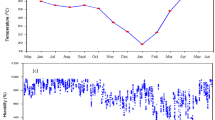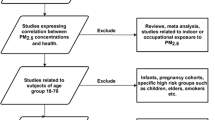Abstract
The study of airborne metals in urban areas is relevant due to their toxic effects on human health and organisms. In this study, we analyzed metals including rare earth elements (REE) in particles smaller than 2.5 μm (PM2.5), collected at five sites around the Mexico City Metropolitan Area (MCMA), during three periods in 2011: April (dry-warm season, DW), August (rainy season, R), and November (dry-cold season, DC). Principal component analysis allowed identifying factors related to geogenic sources and factors related to anthropogenic sources. The recognition of the high impact of geogenic sources in PM2.5 is in agreement with the REE distribution patterns, which show similar behavior as those shown by igneous rocks, confirming the influence of the regional geogenic material. Metals associated to geogenic sources showed higher concentration (p < 0.05) at NE of the MCMA and a significant correlation with prevalent winds. Geogenic metals show similar seasonal distribution, with the highest concentration during DW (p < 0.05), suggesting a possible metal resuspension effect which affects more significantly at lower relative humidity (RH). The metals associated with anthropogenic sources are in agreement with the urban complexity of the area, showing homogenous distribution throughout MCMA (p > 0.05) and no similar seasonal pattern among them. These unexpected results exposed outstanding information regarding the identification of different geogenic sources as the main contributors of metals in the atmospheric environment in the MCMA and highlighted the importance of meteorology in the spatial and seasonal metal patterns.







Similar content being viewed by others
References
Amador-Muñoz, O., Villalobos-Pietrini, R., Miranda, J., & Vera-Avila, L. E. (2011). Organic compounds of PM2.5 in Mexico Valley: spatial and temporal patterns, behavior and sources. Science of the Total Environment, 409(8), 1453–1465. https://doi.org/10.1016/j.scitotenv.2010.11.026.
Amato, F., Pandolfi, M., Viana, M., Querol, X., Alastuey, A., & Moreno, T. (2009). Spatial and chemical patterns of PM 10 in road dust deposited in urban environment. Atmospheric Environment, 43(9), 1650–1659. https://doi.org/10.1016/j.atmosenv.2008.12.009.
Chen, Y., Schleicher, N., Chen, Y., Chai, F., & Norra, S. (2014). The influence of governmental mitigation measures on contamination characteristics of PM2.5 in Beijing. Science of the Total Environment, 490, 647–658. https://doi.org/10.1016/j.scitotenv.2014.05.049.
Cheng, Y., Lee, S. C., Ho, K. F., Chow, J. C., Watson, J. G., Louie, P. K. K., Cao, J. J., & Hai, X. (2010). Chemically-speciated on-road PM2.5 motor vehicle emission factors in Hong Kong. Science of the Total Environment, 408(7), 1621–1627. https://doi.org/10.1016/j.scitotenv.2009.11.061.
Chow, J. C., Watson, J. G., Edgerton, S. A., & Vega, E. (2002). Chemical composition of PM2.5 and PM10 in Mexico City during winter 1997. Science of the Total Environment, 287(3), 177–201. https://doi.org/10.1016/S0048-9697(01)00982-2.
Costello, A. B., & Osborne, J. W. (2005). Best practices in exploratory factor analysis: four recommendations for getting the most from your analysis. Practical Assessment, Research & Evaluation, 10(7), 1–9.
Dockery, D. W., & Pope, C. A. (1994). Acute respiratory effects of particulate air pollution. Annual Review of Public Health, 15, 107–132.
Dongarrà, G., Manno, E., Varrica, D., Lombardo, M., & Vultaggio, M. (2010). Study on ambient concentrations of PM 10, PM 10–2.5, PM 2.5 and gaseous pollutants. Trace elements and chemical speciation of atmospheric particulates. Atmospheric Environment, 44(39), 5244–5257.
Evensen, N. M., Hamilton, P. J., & O'nions, R. K. (1978). Rare-earth abundances in chondritic meteorites. Geochimica et Cosmochimica Acta, 42(8), 1199–1212. https://doi.org/10.1016/0016-7037(78)90114-X.
Feng, S., Gao, D., Liao, F., Zhou, F., & Wang, X. (2016). The health effects of ambient PM 2.5 and potential mechanisms. Ecotoxicology and Environmental Safety, 128, 67–74. https://doi.org/10.1016/j.ecoenv.2016.01.030.
Finlayson-Pitts, B.J., Pitts, Jr. J.N. (2000). Chemistry of the upper and lower atmosphere-. Theory, experiments, and applications. Academic Press. USA. ISBN 0-12-257060-x
Gao, Y., Guo, X., Ji, H., Li, C., Ding, H., Briki, M., Tang, L., & Zhang, Y. (2016). Potential threat of heavy metals and PAHs in PM2. 5 in different urban functional areas of Beijing. Atmospheric Research, 178, 6–16.
Gauderman, W. J., Avol, E., Gilliland, G. F., Vora, H., Duncan Thomas, M. S., Berhane, K., McConnel, R., Kuenzli, M., Lurmann, F., Rappaport, E., Margolis, H., Bates, D., & Peters, J. (2004). The effect of air pollution on lung development from 10 to 18 years of age. New England Journal of Medicine, 351, 1057–1067.
Guzmán-Morales, J., Morton-Bermea, O., Hernández-Álvarez, E., Rodríguez-Salazar, M. T., García-Arreola, M. E., & Tapia-Cruz, V. (2011). Assessment of atmospheric metal pollution in the urban area of Mexico City, using Ficus benjamina as biomonitor. Bulletin of Environmental Contamination and Toxicology, 86(5), 495–500. https://doi.org/10.1007/s00128-011-0252-9.
Hieu, N. T., & Lee, B. K. (2010). Characteristics of particulate matter and metals in the ambient air from a residential area in the largest industrial city in Korea. Atmospheric Research, 98(2), 526–537. https://doi.org/10.1016/j.atmosres.2010.08.019.
Hu, Z. (2009). Spatial analysis of MODIS aerosol optical depth, PM2.5 and chronic coronary heart disease. International Journal of Health Geographics, 8(1), 27. https://doi.org/10.1186/1476-072X-8-27.
Jáuregui, O. E. (2000). El clima de la Ciudad de México (p. 2000). UNAM, México: Plaza y Valdés.
Karanasiou, A. A., Thomaidis, N. S., Eleftheriadis, K., & Siskos, P. A. (2005). Comparative study of pretreatment methods for the determination of metals in atmospheric aerosol by electrothermal atomic absorption spectrometry. Talanta, 65(5), 1196–1202. https://doi.org/10.1016/j.talanta.2004.08.044.
Karthikeyan, S., Joshi, U. M., & Balasubramanian, R. (2006). Microwave assisted sample preparation for determining water-soluble fraction of trace elements in urban airborne particulate matter: evaluation of bioavailability. Analytica Chimica Acta, 576(1), 23–30. https://doi.org/10.1016/j.aca.2006.05.051.
Kulshrestha, A., Satsangi, P. G., Masih, J., & Taneja, A. (2009). Metal concentration of PM2.5 and PM10 particles and seasonal variations in urban and rural environment of Agra, India. The Science of the Total Environment, 407(24), 6196–6204. https://doi.org/10.1016/j.scitotenv.2009.08.050.
Ma, Q. Y., Huang, D. Y., Zhang, H. J., Wang, S., & Chen, X. F. (2017). Exposure to particulate matter 2.5 (PM2.5) induced macrophage-dependent inflammation, characterized by increased Th1/Th17 cytokine secretion and cytotoxicity. International Immunopharmacology, 50, 139–145. https://doi.org/10.1016/j.intimp.2017.06.019.
Miranda, J., Crespo, I., & Morales, M. A. (2000). Absolute principal component analysis of atmospheric aerosols in Mexico City. Environemental Science and Pollution Research, 7(1), 14–18. https://doi.org/10.1065/espr199910.006.
Miranda, J., Barrera, V. A., Espinosa, A. A., Galindo, O. S., & Meinguer, J. (2005). PIXE analysis of atmospheric aerosols in Mexico City. X-Ray Spectrometry, 34(3), 315–319. https://doi.org/10.1002/xrs.823.
Moreno, T., Querol, X., Alastuey, A., Viana, M., Salvador, P., De la Campa, A., Artiñano, B., de la Rosa, J., & Gibbons, W. (2006a). Variations in atmospheric PM trace metal content in Spanish towns: illustrating the chemical complexity of the inorganic urban aerosol cocktail. Atmospheric Environment, 40(35), 6791–6803. https://doi.org/10.1016/j.atmosenv.2006.05.074.
Moreno, T., Querol, X., Castillo, S., Alastuey, A., Cuevas, E., Herrmann, L., Mounkaila, M., Josef, E., & Gibbons, W. (2006b). Geochemical variations in aeolian mineral particles from the Sahara–Sahel Dust Corridor. Chemosphere, 65(2), 261–270. https://doi.org/10.1016/j.chemosphere.2006.02.052.
Moreno-Rodríguez, V., Del Rio-Salas, R., Adams, D. K., Ochoa-Landin, L., Zepeda, J., Gómez-Alvarez, A., Palafox-Reyes, J., & Meza-Figueroa, D. (2015). Historical trends and sources of TSP in a Sonoran desert city: Can the North America Monsoon enhance dust emissions? Atmospheric Environment, 110, 111–121. https://doi.org/10.1016/j.atmosenv.2015.03.049.
Morton-Bermea, O., Hernández-Álvarez, E., González-Hernández, G., Romero, F., Lozano, R., & Beramendi-Orosco, L. E. (2009a). Assessment of heavy metal pollution in urban topsoils from the metropolitan area of Mexico City. Journal of Geochemical Exploration, 101(3), 218–224. https://doi.org/10.1016/j.gexplo.2008.07.002.
Morton-Bermea, O., Hernandez, E., Martinez-Pichardo, E., Soler-Arechalde, A. M., Santa-Cruz, R. L., Gonzalez-Hernandez, G., Beramendi-Orosco, L., & Urrutia-Fucugauchi, J. (2009b). Mexico City topsoils: heavy metals vs. magnetic susceptibility. Geoderma, 151(3), 121–125. https://doi.org/10.1016/j.geoderma.2009.03.019.
Pinkerton, K. E., Green, F. H. Y., Saiki, C., Vallyathan, V., Plopper, C. G., Gopal, V., Hung, D., Bahne, E. B., Lin, S., Ménache, M. G., & Schenker, M. B. (2000). Distribution of particulate matter and tissue remodeling in the human lung. Environmental Health Perspectives, 108(11), 1063–1069. https://doi.org/10.1289/ehp.001081063.
Pope, C. A., Dockery, D., & Schwartz, J. (1995). Review of epidemiological evidence of health effects of particulate air pollution. Inhalation Toxicology, 7, 1–18.
Pope, C. A., Burnett, R. T., Thun, M. J., Calle, E. E., Krewski, D., Ito, K., & Thurston, G. D. (2002). Lung cancer, cardiopulmonary mortality, and long-term exposure to fine particulate air pollution. JAMA, 287(9), 1132–1141. https://doi.org/10.1001/jama.287.9.1132.
Querol, X., Alastuey, A., Viana, M. M., Rodriguez, S., Artiñano, B., Salvador, P., Garcia Dos Santos, S., Fernandez-Patier, R., Ruiz, C. R., de la Rosa, J., Sánchez de la Campa, A., Menendez, M., & Gil, J. I. (2004). Speciation and origin of PM10 and PM2.5 in Spain. Journal of Aerosol Science, 35(9), 1151–1172. https://doi.org/10.1016/j.jaerosci.2004.04.002.
Querol, X., Pey, J., Minguillón, M. C., Pérez, N., Alastuey, A., Viana, M., Moreno, T., Bernabé, R. M., Blanco, S., Cárdenas, B., Vega, E., Sosa, G., Escalona, S., Ruiz, H., & Artiñano, B. (2008). PM speciation and sources in Mexico during the MILAGRO-2006 campaign. Atmospheric Chemistry and Physics, 8(1), 111–128.
Ragosta, M., Caggiano, R., Macchiato, M., Sabia, S., & Trippetta, S. (2008). Trace elements in daily collected aerosol: level characterization and source identification in a four-year study. Atmospheric Research, 89(1), 206–217. https://doi.org/10.1016/j.atmosres.2008.01.009.
Ravindra, K., Stranger, M., & Van Grieken, R. (2008). Chemical characterization and multivariate analysis of atmospheric PM2.5 particles. Journal of Atmospheric Chemistry, 59(3), 199–218. https://doi.org/10.1007/s10874-008-9102-5.
Rodríguez-Salazar, M. T., Morton-Bermea, O., Hernández-Álvarez, E., Lozano, R., & Tapia-Cruz, V. (2011). The study of metal contamination in urban topsoils of Mexico City using GIS. Environment and Earth Science, 62(5), 899–905. https://doi.org/10.1007/s12665-010-0584-5.
Rolph, G., Stein, A., & Stunder, B. (2017). Real-time Environmental Applications and Display system: READY. Environmental Modelling and Software, 95, 210–228. https://doi.org/10.1016/j.envsoft.2017.06.025.
Rosas, I., Belmont, R., & Jauregui, E. (1995). Seasonal variation of atmospheric lead levels in three sites in Mexico City. Atmosfera, 8(4).
Stein, A. F., Draxler, R. R., Rolph, G. D., Stunder, B. J. B., Cohen, M. D., & Ngan, F. (2015). NOAA’s HYSPLIT atmospheric transport and dispersion modeling system. Bulletin of the American Meteorological Society, 96(12), 2059–2077. https://doi.org/10.1175/BAMS-D-14-00110.1.
Xu, L., Chen, X., Chen, J., Zhang, F., He, C., Zhao, J., & Yin, L. (2012). Seasonal variations and chemical compositions of PM2.5 aerosol in the urban area of Fuzhou, China. Atmospheric Research, 104, 264–272.
Yuan, Z., Lau, A. K. H., Zhang, H., Yu, J. Z., Louie, P. K., & Fung, J. C. (2006). Identification and spatiotemporal variations of dominant PM 10 sources over Hong Kong. Atmospheric Environment, 40(10), 1803–1815. https://doi.org/10.1016/j.atmosenv.2005.11.030.
Zhai, Y., Liu, X., Chen, H., Xu, B., Zhu, L., Li, C., & Zeng, G. (2014). Source identification and potential ecological risk assessment of heavy metals in PM 2.5 from Changsha. Sci. The Science of the Total Environment, 493, 109–115. https://doi.org/10.1016/j.scitotenv.2014.05.106.
Zhang, R., Jing, J., Tao, J., Hsu, S. C., Wang, G., Cao, J., Lee, C. S. L., Zhu, L., Chen, Z., Zhao, Y., & Shen, Z. (2013). Chemical characterization and source apportionment of PM2.5 in Beijing: seasonal perspective. Atmospheric. Chemical Physics, 13(14), 7053–7074.
Zhao, X., Zhang, X., Xu, X., Xu, J., Meng, W., & Pu, W. (2009). Seasonal and diurnal variations of ambient PM2.5 concentration in urban and rural environments in Beijing. Atmospheric Environment, 43(18), 2893–2900. https://doi.org/10.1016/j.atmosenv.2009.03.009.
Zhou, Z., Shao, T., Qin, M., Miao, X., Chang, Y., Sheng, W., Wu, F., & Yu, Y. (2017). The effects of autophagy on vascular endothelial cells induced by airborne PM2.5. Journal of Environmental Sciences. https://doi.org/10.1016/j.jes.2017.05.019.
Acknowledgements
The authors gratefully acknowledge the NOAA Air Resources Laboratory (ARL) for the provision of the HYSPLIT transport and dispersion model and/or READY website (http://www.ready.noaa.gov) used in this publication.
Funding
This study was performed with financial support of Project 166295 from CONACyT (Consejo Nacional de Ciencia y Tecnología) and Project CPSG/087A/2014 FA from the SECyTI (Secretaría de Ciencia y Tecnología e Inovacción) as well as from Project IN116614 from DGAPA (Dirección General de Personal Académico, UNAM).
Author information
Authors and Affiliations
Corresponding author
Rights and permissions
About this article
Cite this article
Morton-Bermea, O., Garza-Galindo, R., Hernández-Álvarez, E. et al. Recognition of the importance of geogenic sources in the content of metals in PM2.5 collected in the Mexico City Metropolitan Area. Environ Monit Assess 190, 83 (2018). https://doi.org/10.1007/s10661-017-6443-z
Received:
Accepted:
Published:
DOI: https://doi.org/10.1007/s10661-017-6443-z




